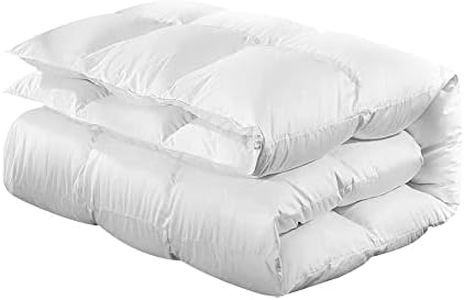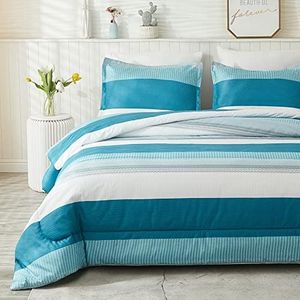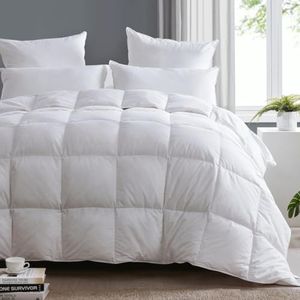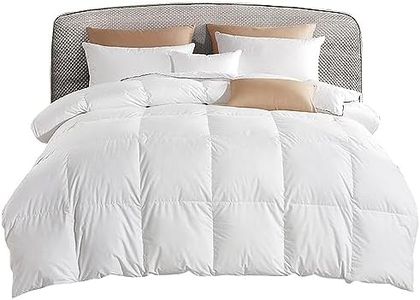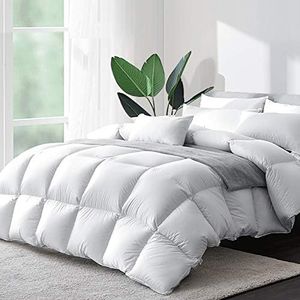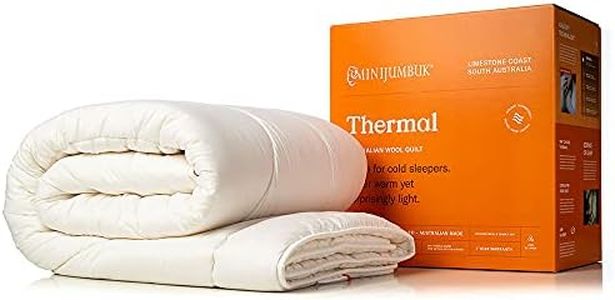We Use CookiesWe use cookies to enhance the security, performance,
functionality and for analytical and promotional activities. By continuing to browse this site you
are agreeing to our privacy policy
10 Best Down Comforter
From leading brands and best sellers available on the web.Buying Guide for the Best Down Comforter
Choosing the right down comforter can significantly improve your sleep comfort and bedroom experience. It's important to focus on how warm you want to be, how soft you like your bedding, and whether you have any allergies. Understanding the key features will help you pick a down comforter that feels just right for you and matches your sleeping habits.Fill PowerFill power measures the fluffiness and insulating ability of the down in your comforter. Higher fill power means the down clusters are larger and trap more air, leading to better insulation and warmth with less weight. Fill power typically ranges from about 500 to 900. A lower fill power (500-600) offers lighter warmth and is good for warmer climates or hot sleepers. Medium fill power (600-750) provides good warmth for most people and most seasons. Higher fill power (750 and above) means premium fluffiness and warmth, great for cold environments or if you love to be cozy and warm. Consider your climate and whether you sleep hot or cold to find the right fill power for you.
Fill WeightFill weight is the actual amount of down inside the comforter, usually measured in ounces or grams. More weight generally means more warmth, but this interacts with fill power—high fill power needs less weight for the same warmth. Light fill weight comforters are best for warmer weather or if you want something airy. Medium fill weight is great for year-round use. Heavy fill weight provides maximum warmth for those who get cold easily or live in chilly climates. When choosing, think about how warm you like to be at night and the temperature of your bedroom.
Down TypeThe type of down used can be from goose, duck, or sometimes a blend, and affects how soft, lofty, and insulating the comforter is. Goose down is often softer and loftier, making it more luxurious, while duck down is generally a bit less expensive but still provides good insulation and comfort. Some comforters may use a mix for balance. If you prioritize softness and fluff, goose down may be preferable, while duck down can be a great practical choice. Consider your preference for feel and, if relevant, ethical sourcing labels like 'responsible down.'
Cover MaterialThe outer fabric, or shell, of the comforter affects its feel, durability, and breathability. Common materials include cotton, polyester, or a blend. Cotton is breathable and soft, perfect for sensitive skin, while polyester may be more wrinkle-resistant or budget-friendly. High thread count in the fabric usually makes it softer and helps keep the down from leaking out. Pick a shell material based on what feels good to you against your skin and whether you prioritize breathability or easy care.
ConstructionHow the comforter is stitched influences how evenly the down is distributed. 'Baffle box' construction uses small cubes to prevent down from shifting, keeping warmth even across the comforter. 'Sewn-through' construction stitches the top and bottom layers together, which can create cold spots but is lighter and often less expensive. There are also 'gusseted' options for extra loft. If you want steady warmth throughout the night, go for baffle box. For a lighter feel and if you don't mind possible slight unevenness, sewn-through can work well.
Allergy ConsiderationsSome people are allergic to down or dust mites that can accumulate in bedding. Hypoallergenic down is washed and processed to remove allergens, making it suitable for most with mild allergies. Synthetic alternatives are available as well if you need a non-down option. If you have allergies, look for comforters labeled 'hypoallergenic' and consider how easy the comforter is to clean.
